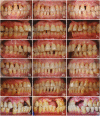Malocclusions, pathologic tooth migration, and the need for orthodontic treatment in subjects with stage III-IV periodontitis. A cross-sectional study
- PMID: 36869811
- PMCID: PMC10389061
- DOI: 10.1093/ejo/cjad003
Malocclusions, pathologic tooth migration, and the need for orthodontic treatment in subjects with stage III-IV periodontitis. A cross-sectional study
Abstract
Background: Literature is scarce on malocclusion prevalence and orthodontic treatment need (OTN) in subjects with stage III-IV periodontitis. Study aims were to assess prevalence of primary and secondary malocclusions in subjects with stage III-IV periodontitis and OTN based on pathologic tooth migration (PTM) and occlusal trauma of anterior teeth (AT).
Subjects and methods: One hundred and twenty-one subjects with stage III-IV periodontitis were examined. A comprehensive periodontal-orthodontic examination was performed. Exclusion criteria: age <30 years, removable prosthetics, uncontrolled diabetes, pregnancy/lactation, and oncologic disease.
Results: Class II malocclusion was found in 49.6% (Class II div 1-20.7%, Class II div 2-9.9%, subdivision Class II-19.0%), Class I-31.4%, Class III-10.7%, no malocclusion-8.3% of subjects. PTM was observed in 74.4% of maxillary and 60.3% of mandibular AT. Spacing and extrusion were the main types of PTM of AT. Odds ratio for PTM of maxillary AT was 9.3 in cases with >30% of sites with clinical attachment loss ≥5 mm (P = 0.001). Spacing of maxillary AT was influenced by periodontitis, Class III malocclusion, and lost teeth. Tongue habit had impact on spacing of mandibular AT. Dental Health Component of Index of Orthodontic Treatment Need yielded that OTN was found in >50% and OTN due PTM, occlusal trauma and impaired function in 66.1% of subjects.
Conclusions: The most prevalent malocclusion was Class II. Spacing and extrusion were prevalent types of PTM of AT. OTN was found in more than half of the subjects. The study highlights the need for preventive measures for PTM in subjects with stage III-IV periodontitis.
© The Author(s) 2023. Published by Oxford University Press on behalf of the European Orthodontic Society.
Conflict of interest statement
None to declare.
Figures


Similar articles
-
Knowledge, attitudes, and interest in orthodontic treatment: a cross-sectional study in adults with stage III-IV periodontitis and secondary malocclusions.BMC Oral Health. 2023 Nov 11;23(1):853. doi: 10.1186/s12903-023-03605-8. BMC Oral Health. 2023. PMID: 37951899 Free PMC article.
-
Comprehensive treatment for severe periodontitis with pathologic tooth migration-related bimaxillary protrusion: A case report with 3-year follow-up.J Am Dent Assoc. 2021 Jun;152(6):471-482.e2. doi: 10.1016/j.adaj.2021.02.017. J Am Dent Assoc. 2021. PMID: 34044978
-
Pathologic tooth migration.J Periodontol. 2005 Jun;76(6):859-66. doi: 10.1902/jop.2005.76.6.859. J Periodontol. 2005. PMID: 15948679 Review.
-
An interdisciplinary treatment to manage pathologic tooth migration: a clinical report.J Prosthet Dent. 2011 Sep;106(3):153-8. doi: 10.1016/S0022-3913(11)60114-5. J Prosthet Dent. 2011. PMID: 21889001
-
Significance of occlusion in the etiology and treatment of early, moderate, and advanced periodontitis.J Periodontol. 1981 Sep;52(9):511-7. doi: 10.1902/jop.1981.52.9.511. J Periodontol. 1981. PMID: 6793705 Review.
Cited by
-
Expert consensus on orthodontic treatment of patients with periodontal disease.Int J Oral Sci. 2025 Apr 3;17(1):27. doi: 10.1038/s41368-025-00356-w. Int J Oral Sci. 2025. PMID: 40175337 Free PMC article. Review.
-
Knowledge, attitudes, and interest in orthodontic treatment: a cross-sectional study in adults with stage III-IV periodontitis and secondary malocclusions.BMC Oral Health. 2023 Nov 11;23(1):853. doi: 10.1186/s12903-023-03605-8. BMC Oral Health. 2023. PMID: 37951899 Free PMC article.
-
Spontaneous repositioning of pathologically migratory mandibular anterior teeth following periodontal surgical treatment: a case report with 4-year follow-up and literature review.BMC Oral Health. 2025 May 21;25(1):749. doi: 10.1186/s12903-025-06111-1. BMC Oral Health. 2025. PMID: 40399887 Free PMC article. Review.
-
Strategic sequencing of orthodontic treatment and periodontal regenerative surgery: A literature review.J Dent Sci. 2025 Jul;20(3):1391-1397. doi: 10.1016/j.jds.2025.03.010. Epub 2025 Mar 20. J Dent Sci. 2025. PMID: 40654467 Free PMC article. Review.
-
Orthodontic Management of Different Stages and Grades of Periodontitis According to the 2017 Classification of Periodontal Diseases.Dent J (Basel). 2025 Jan 29;13(2):59. doi: 10.3390/dj13020059. Dent J (Basel). 2025. PMID: 39996933 Free PMC article. Review.
References
-
- Darveau, R. (2010) Periodontitis: a polymicrobial disruption of host homeostasis. Nature Reviews Microbiology, 8, 481–490. - PubMed
-
- Genco, R.J. and Borgnakke, W.S. (2013) Risk factors for periodontal disease. Periodontology 2000, 62, 59–94. - PubMed
-
- Jepsen, S., et al. . (2018) Periodontal manifestations of systemic diseases and developmental and acquired conditions: consensus report of workgroup 3 of the 2017 World Workshop on the Classification of Periodontal and Peri-Implant Diseases and Conditions. Journal of Clinical Periodontology, 45, S219–S229. - PubMed

